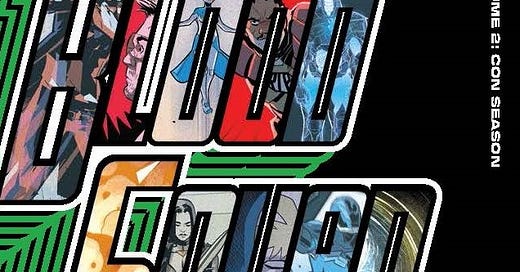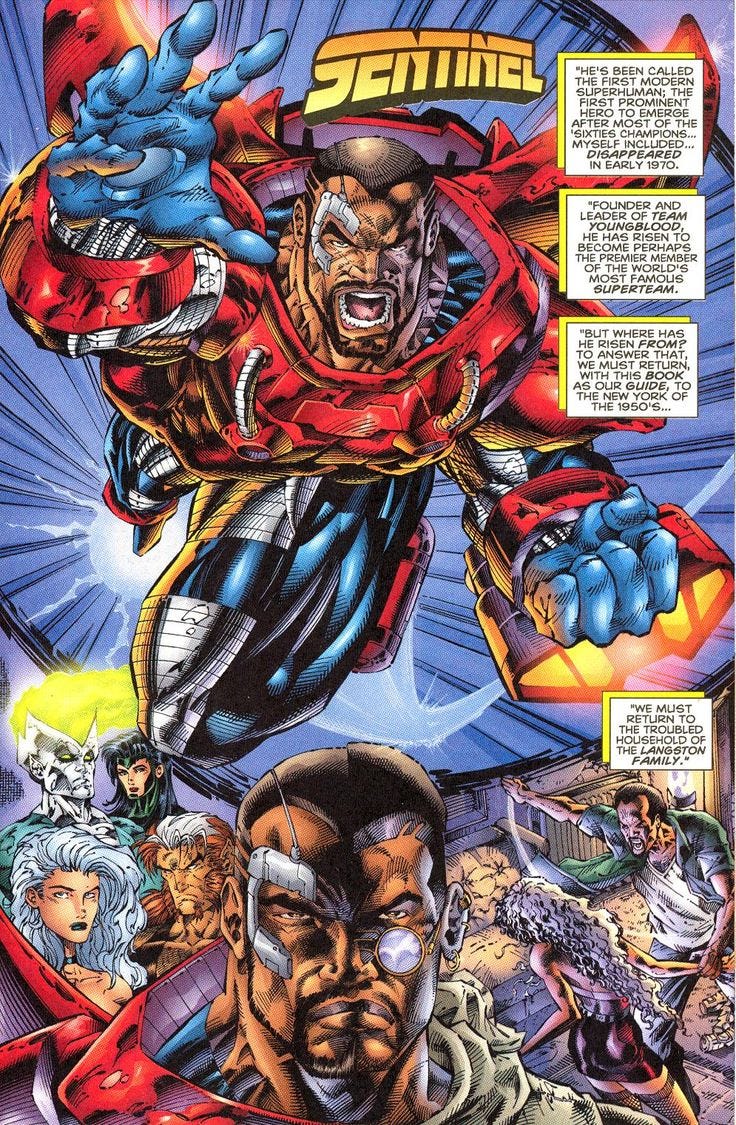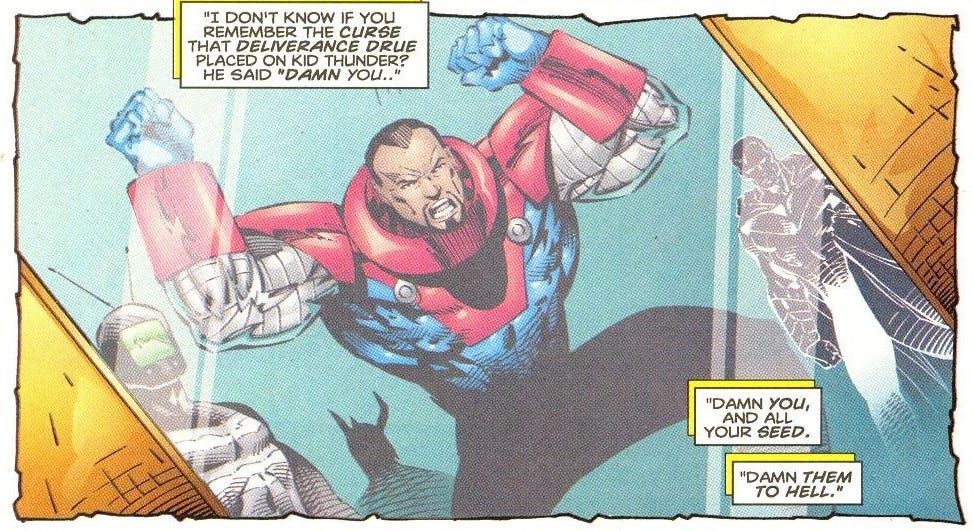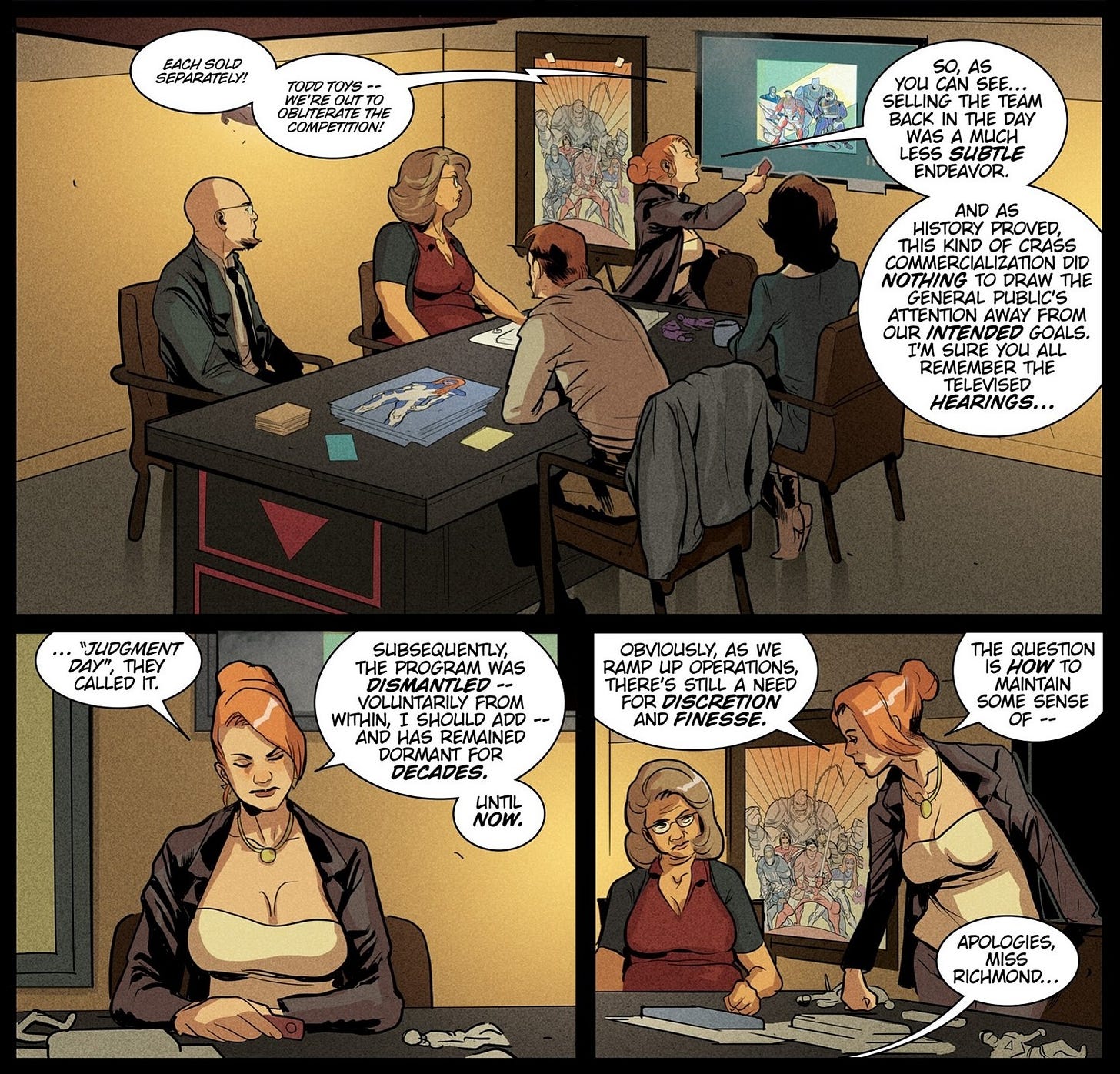Well, let’s see how this one lands…
For those who may not be aware, I’m currently writing a monthly superhero series for Image Comics called BLOOD SQUAD SEVEN. Check out this previous newsletter for a deeper dive into the premise of the series, my interest in the source material and my personal ambitions for it. Or this one to get even more info. I’m just too lazy to do a full recap here.
Besides, this week you can go out and buy a brand-new book release: the 2nd volume of the trade paperback editions of the series, titled BLOOD SQUAD SEVEN VOL. 2: CON SEASON, which collects issues #5-8 and the first STRIKEFILE issue. It’s drawn by a killer artist, Paul Fry, and it’s a blast of a book. Just look for this swanky cover, brilliantly designed by Sonia Harris…
And then, starting next month, we begin an all-new storyline in the monthly series with issue #9…
… and we’re all pretty psyched about it. It takes all of the vast, foundational groundwork we’d laid down in the first two story arcs and pushes it into the current moment in a significantly intense way. There’s a real sociopolitical edge to this storyline, employing more of a wider global perspective than we have so far. In a way, I knew it would allow us to tap more deeply in the series’ stated Watchmen influence (which, let’s be honest, is always going to be an influence when you try and take superheroes more seriously). But then that got me thinking…
With the Blood Squad Seven concept being an admitted analogue of the original Image Comics series, Youngblood, there was one specific aspect of that series’ history that I had yet to deal with, but I recently realized… it was something that actually should be dealt with.
Y’see… back in the day, a few years before I went pro, I keenly observed the launch of Image Comics with a genuine, creative curiosity. I was a little too old to be a fan, per se… but I was definitely interested. I bought most of them and made significant efforts to understand what the founders were trying to do. Because I knew it was the beginning of… something.
Among those early Image Comics, there were two specific characters that I felt some sort of weird connection to: one was Dutch (created by Chap Yaep) and the other was Sentinel (created by Youngblood creator, Rob Liefeld).
Who the hell knows if Liefeld was wholly aware of this, but Sentinel -- as a character -- was fairly progressive for its time. Sure, you could dismiss Sentinel as simply a “black Iron Man”, but you might be ignoring just how important to a younger reader of that early Image era -- one who had probably never heard of Iron Man (remember this was long before Robert Downey Jr. and the MCU) -- this character might be. In fact, as a role model, he had a bit more over Iron Man. Sentinel was married. He was sober. He was the smart, level-headed leader of Team Youngblood. Perhaps most importantly, he didn’t hide his face -- and, more significantly, his race -- behind a mask.
In 1995, my first official, professional sale as a comicbook writer was to Leifeld’s Extreme Studios (bought by current Image Comics publisher, Eric Stephenson, who was Extreme’s editor-in-chief at the time) and it was a short, 10-pager starring -- you guess it -- Dutch and Sentinel. It was meant for the Youngblood: Strikefile series, but the story never saw print. Nevertheless, it gave my early writing career an injection of much-needed legitimacy.
Nearly thirty years later, the lead-in to BLOOD SQUAD SEVEN happened to be a DUTCH mini-series I did with artists Nathan Fox and Simon Gane. So, you can imagine how the circle was starting to close in a really satisfying way.
But, as it turns out, I’m still not quite done. I had dealt with Dutch. Now it’s going to be Sentinel’s turn… so to speak. Unlike Dutch (who’s creator and owner, Chap Yaep, had generously given us his blessing to tell our story), Sentinel was never going to be available to us. But that’s okay… because we know how to get around that, don’t we? And like I said earlier, it’s gotta be done. As far as I’m concerned, there’s a wrong that needs to be righted.
Because back in 1997, a very unlikely “event series” hit comicbook stores, one that I was legitimately excited for. It was called JUDGEMENT DAY. Published by Rob Liefeld’s new publishing venture, Awesome Comics, it was a fairly massive retooling of Rob’s Extreme characters (including Youngblood) -- written by none other than Alan Moore -- that turned out to be the final story that connected Liefeld’s characters to the Image Comics Universe (where it was originally a vital component, before unfortunate legal matters caused it to permanently detach itself from the rest of Image continuity).
Now, before we go any further: If you haven’t read this comicbook… SPOILERS!!!!!
Okay, you’ve been warned.
The basic story revolved around a murder trial initially involving the premier “celebrity superhero” team known as Youngblood. Apparently, one member of Youngblood (Knightsabre) had killed another member (Riptide). During the subsequent trial, where Knightsabre was tried by a jury of his peers, the entire, spectacular history of this particular superhero universe was laid out in great detail. Threaded throughout this history was a magical book that had the power to rewrite reality, which eventually tied directly into the murder. In the end, it was revealed that Knightsabre was actually innocent, framed by the actual murderer… who was, as it turned out, a different member of Youngblood: the aforementioned Sentinel.
As well-crafted as Judgement Day might’ve been, one aspect that seemed to be lost on most readers at the time is, in hindsight, almost painfully obvious. I’ll admit, I certainly wasn’t thinking too deeply of how… well, how politically incorrect this particular character development really was. At the time, I just remember being somewhat incensed that a cool, unique superhero character -- Sentinel -- had been arbitrarily forced into this new, villain role. Yes, there was a story rationale… but, in my opinion, a relatively convoluted one, difficult to grasp in a casual read and, one could claim, slightly insulting to the material that had come before it.
Then again, it’s Alan Moore. I mean, he’s one of the greatest comicbook writers that ever lived, right? So much of what he’s written has meant so much to me over many decades of my life. In other words, my own personal affection for his work means that he pretty much gets an automatic pass from me, no matter what kind of weird shit he does. And there’s plenty of weird shit you could point to. Of course, for me, that just makes him more interesting… both as a creator and as a prominent figure within our industry.
But this is one of the few times where I have what I feel is a legitimate gripe of his work. Certainly of this particular story choice.
At the time, Moore was pimping Judgement Day in the press as a return to “imagination” in comicbooks (a position which, admittedly, ended up being fairly influential on where mainstream comicbooks actually went in the final years of the Twentieth Century), but behind the scenes -- even according to Rob Liefeld (during an interview with the much beloved and dearly departed Cartoonist Kayfabe YouTube channel) -- he clearly had a much more “real-world” element that influenced this storyline: the then-recent murder trial of O.J. Simpson.
Y’see, in terms of celebrity pop culture events of the mid-1990’s, there was nothing bigger than that trial. It was in the zeitgeist to an unbelievable degree. An unavoidable degree. And Alan Moore, despite any mystical reputation he may have cultivated to the contrary, was generally plugged in to what was happening in pop culture at any given moment, especially when it was televised. At least, back then he was.
I suppose an argument could be made that any mention of the O.J. trial during the initial promotion for the series might’ve tipped off readers that Sentinel was, in fact, the surprise murderer. However, Moore did, in fact, make an offhand reference to it in a single online interview, but only to sell the scale of the story, telling the interviewer: “… this is going to make the O.J. Simpson trial look pretty tiny in comparison because it goes right back to before there was life on Earth.”
So clearly Moore was aware of the parallels. He knew what he was doing. He knew that being somewhat topical was going to inject a certain type of energy into the work. Although, in his story… the Black “celebrity superhero” was found guilty. Wish fulfillment on Moore’s part? Who the hell knows? Regardless, to me, that only added to the fact that it hasn’t aged particularly well.
But no one else ever really talked about it. No one talked about how bizarre it was to arbitrarily turn the stalwart, respected Black hero into a cold-blooded murderer… and how deliberate a move it was on Moore’s part. Which I still find a little strange. Granted, Judgement Day is a relatively minor work in Moore’s oeuvre. Honestly, it’d be difficult to find anyone talking about it, anywhere. You’d have to really go digging. And I certainly don’t think it’s the kind of thing that you could ever get away with today. It’s just really odd to me. The only real reference I found regarding the unfortunate optics of this choice was this article from 2022, written by excellent comicbook journalist, Graeme McMillan. He says:
“The reduction of Sentinel -- a Black man who, prior to this story’s substantial retcon, had been one of the smartest men in his fictional world -- to an embittered child of a drug addict whose only path to success relied on theft, murder, and cheating the system stands out…”
But he moves past it fairly quickly with a pithy: “Enough about the admittedly troubling gender and racial politics of the story!” Go figure.
Well, hey… now I’m gonna talk about it. I’m going to deal with it in the upcoming storyline. I’m going after the big fish. I suppose I knew there was a possibility it would eventually come to this, since I even made a casual reference to “judgement day” in the very first issue of BLOOD SQUAD SEVEN last year…
… but now it’s finally time to address this strange, perhaps even unfortunate lapse in character development -- like I said, in the analogous manner in which we’ve always dealt with this series’ inspirations -- head on, and do something about it, starting in BLOOD SQUAD SEVEN #9, on sale in a few short weeks. Watch how I attempt to “fix” a misguided story choice made by one of the greatest comicbook writers of all time.
I mean, who better than me, huh…?
Joe Casey
USA









Oh boy...I am about a decade younger than Joe Casey, so I was actually a rabid fan when Image started, to the point that I left Marvel completely and followed them there exclusively for a few months (I would eventually drop most of their titles, I think I continue collecting Spawn, Dragon and Wildcats for a few years). Eventually I disconnected from most of their titles, but I remember when Liefeld left and the controversy that followed. I actually collected Judgement Day as a fan because of Moore and...I was not impressed. Not only because of the complete character assassination that was the Sentinel recon, but also because he wasn't even allowed to be a nuanced villain going forward. Everything about the character was stripped down, he no longer was smart, a good husband and father, but a hustler that came from the most stereotypical of backgrounds. Because he was a Liefeld creation I think most people don't think twice about it, but there are a lot of problematic tropes with Moore writing.
I thought the same thing when I read Judgment Day. I honestly think that Moore's reputation tends to deflect criticism.